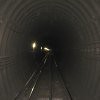North End
Beneath Newington Causeway
Posts: 1,769
|
Post by North End on Oct 30, 2021 15:52:46 GMT
Black plastic bin liners do not last forever and presumably were installed at some stage during the switchover from Conventional light signalling. As a short term (potentially reversible) fix this makes sense but this late in the day I rather doubt the covered up signals will ever be considered for reinstatement. Hopefully the signal lights have all been powered down by now or there is a risk that once those plastic bags degrade after many years in sunlight then it must only be a matter of time before drivers may encounter an unexpected signal aspect light despite being told by the onboard kit that he is cleared to proceed. Is there a programe to remove these potentially distracting legacy signalling? The fuses to the legacy signal aspects are all removed shortly after commissioning, in line with LU's standards. The 4LM project team is only too aware that the bin liners degrade after a period of time and there is a project team within the 4LM portfolio dedicated to redundant assets. The problem is the availability of staff to undertake the removal works, as the same members of staff are also engaged in Earthing and Bonding alterations following the removal of the legacy track circuits, and the removal of redundant capactitors in order to comply with an Environmental Agency directive placed upon TfL. As I'm sure you'll understand, their effords need to be focussed on meeting the organisation's Health and Safety obligations before the removal of anything else. Presumably there’s still some kind of maintenance regime? A year or two after the Barnet branch went over, the entire signal head fell off a running signal near Finchley Central, fortunately without major incident. The bin liners trap water, which must considerably accentuate corrosion. |
|
Deleted
Deleted Member
Posts: 0
|
Post by Deleted on Oct 30, 2021 16:28:13 GMT
There is now since that incident we have to carry out a structure check but thats it for the legacy equipment
|
|
|
|
Post by t697 on Oct 31, 2021 13:28:38 GMT
I see at least some Northern line redundant signals have an 'X' device across the lenses so it's not a water trap or blowing away risk like a bag might be. Still lots of signals not removed though.
Another thing probably not completed after removal of trainstops is filling in the conductor rail gaps to reduce shoegear wear and tear, minimise train 'gapping' and reduce maintenance costs of conductor rail ramps.
|
|
|
|
Post by zbang on Oct 31, 2021 14:48:35 GMT
Not trying to stray too far from the original, but... how often are the conductor rails renewed? Unless there's a really strong reason otherwise, that's the time to de-gap.
|
|
Chris M
Global Moderator
Forum Quizmaster
Always happy to receive quiz ideas and pictures by email or PM
Posts: 19,758
|
Post by Chris M on Oct 31, 2021 16:36:26 GMT
Not trying to stray too far from the original, but... how often are the conductor rails renewed? I've spent quite a while googling this and the best answer I've come up with is that, in Singapore at least, conductor rails are expected to last about 40 years but there are many factors the impact the actual lifespan, including weather, amount of traffic and electrical arcing. I think I remember reading somewhere that conductor rail ramps are replaced more frequently than the main lengths as they experience a greater amount of arcing. |
|
|
|
Post by d7666 on Nov 5, 2021 0:43:37 GMT
It's even a bit older than that. The Lorenz > Alcatel > Thales (and soon Hitachi!) product is a commercial branded version of the generic German LZB (liniezugbeeinflussung) which was under continual developement since 1950s but in fact appeared first in Berlin U-bahn as long ago as late 1920s. The early 1960s German installations were largely but not uniquely developed by Siemens lead; Lorenz was simply another supplier, and typical of German industry all makers got a slice of the pie, even the losing bidders get roles as sub-contractors. The German language wikipedia page is here, seems detailed, but, like everything wikipedia, don't take it as authoritative : de.wikipedia.org/wiki/Linienf%C3%B6rmige_Zugbeeinflussung- run that through the google translator and you'll get a pretty good time line. Today's TBTC \ CBTC metro versions, e.g. Seltrac S40, are a spinoff; same concept, just refined. The fundamental concept is largely the same, progressive generations have been more about increasing processor power, method of transmission etc. The parallel is the ATO on 1967 Victoria, Central and now Victoria [DTG] lines are fundamentally more progessively advanced track circuit based systems; the basic track circuit is very old, if you rationalise the issue the developments are in making frequency encoding more and more complex with each generation, and improved methods of track to train comms along with centralised supervision. In more recent years, well most of this century actually, the generic term LZB tends to not get applied to Seltrac etc; I believe this is because the term LZB (with a suffix number) is in common use for German main line systems and suppliers wish to position their metro products differently. _ Not sure what is there now, but in Neasden SCC SER, the TBTC cabinets at installation actually had LZB logos on them. IIMU since then the kit has been upgraded, but I have no idea if they replaced the cabinets or just the kit .... on the argument you'd actually have to build up the repalcement while the original was running the railway, they might have gone; I don't know what they did; I've not been to NSCC in eons. I once referred to them as Lorenz machines in reference to the WW2 German military encryption machines en.wikipedia.org/wiki/Lorenz_cipherits the same company  |
|












